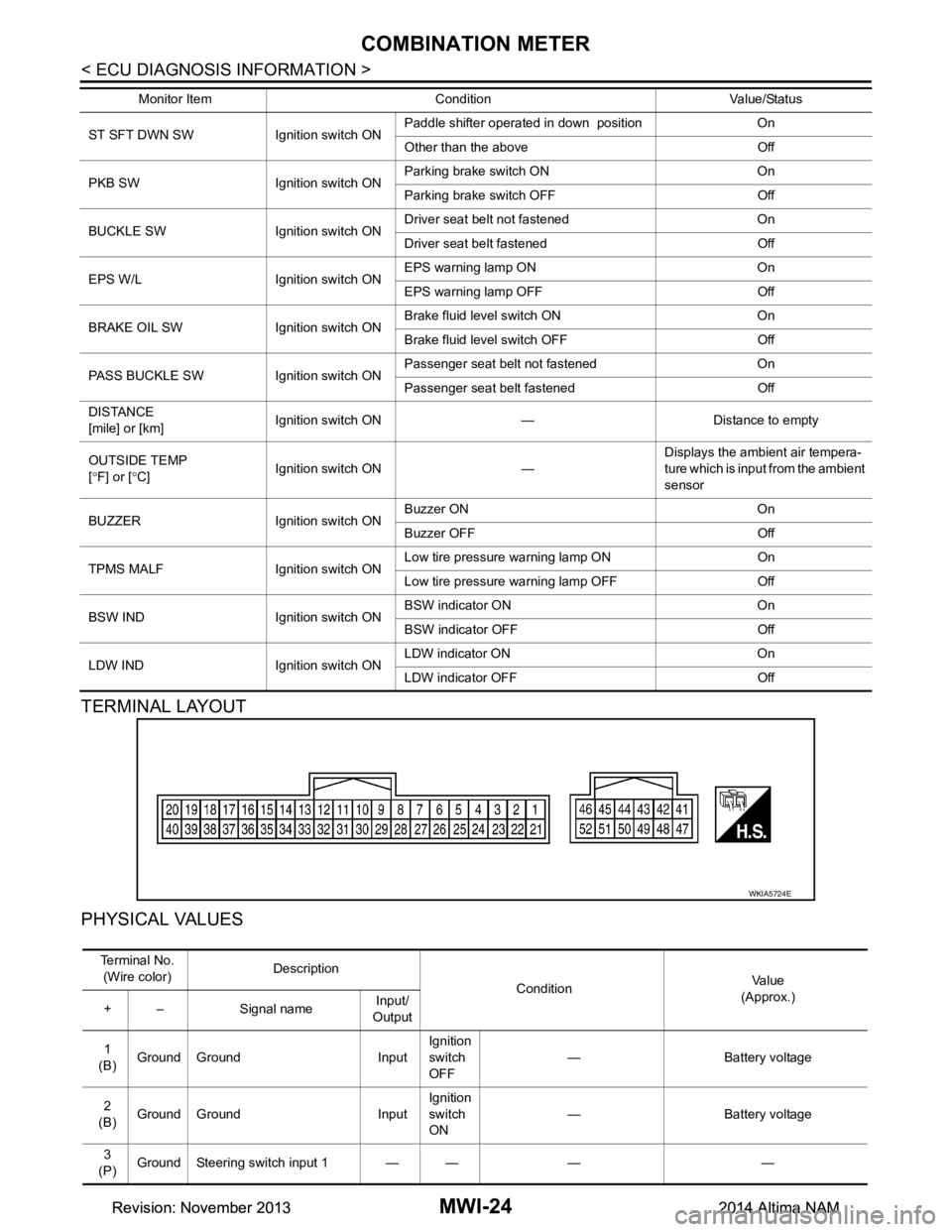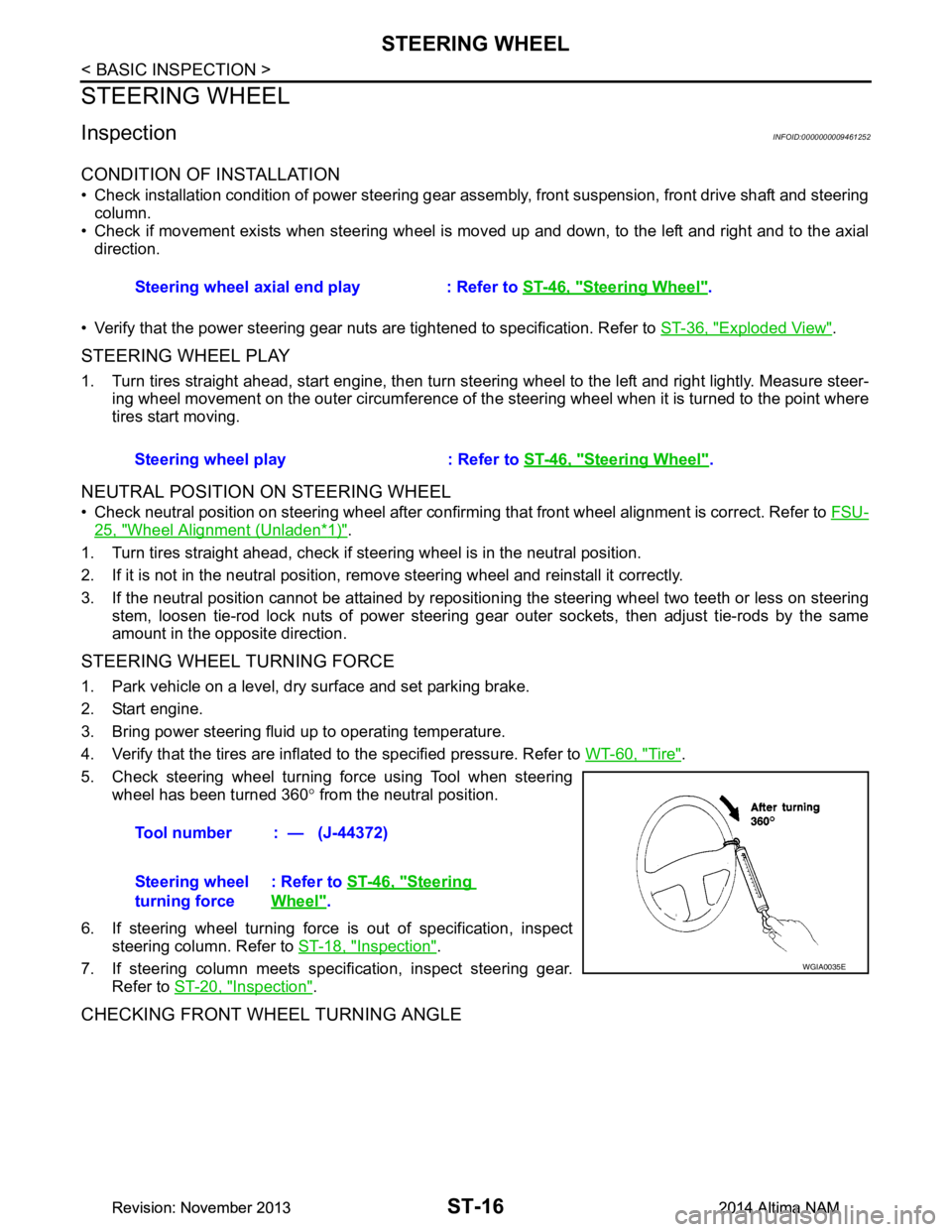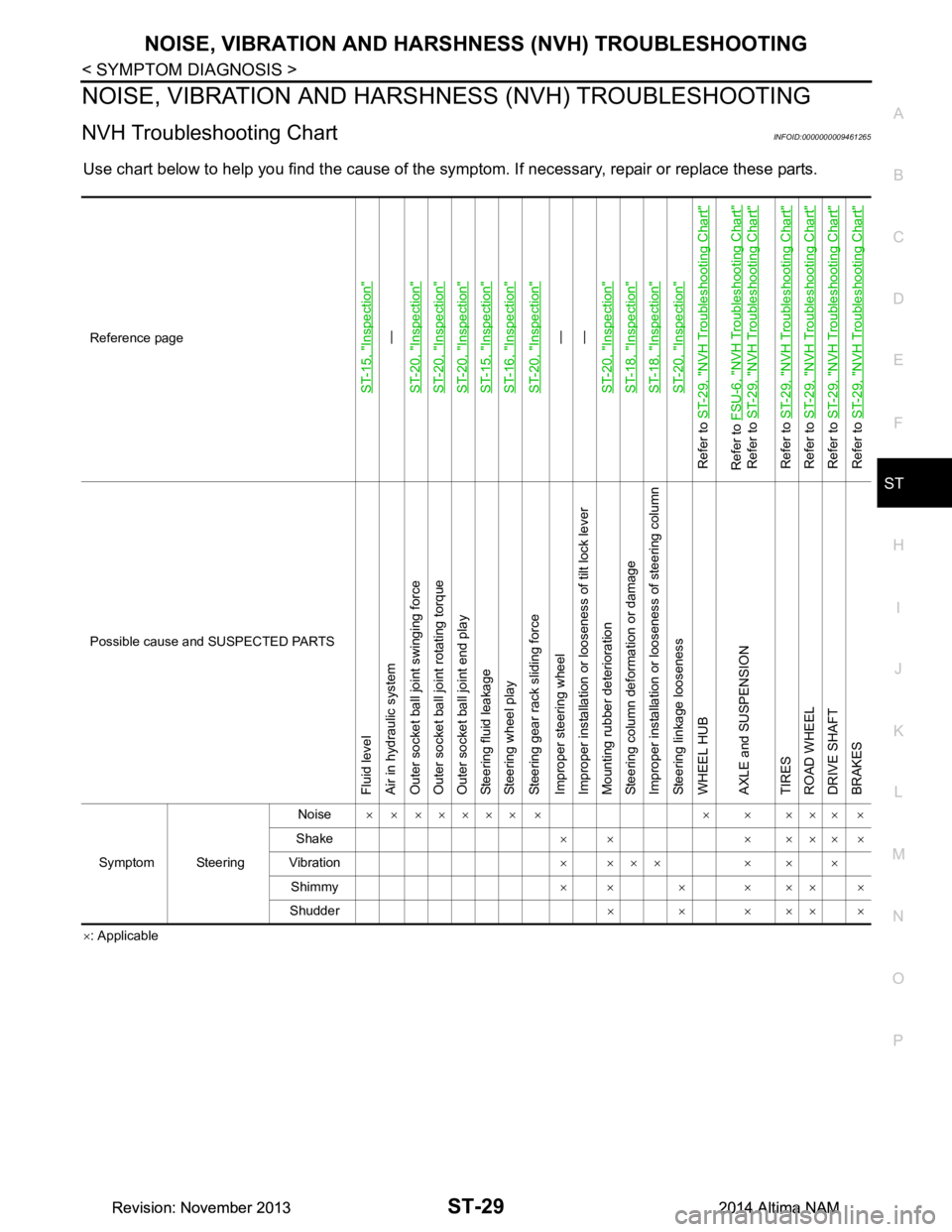2014 NISSAN TEANA brake fluid
[x] Cancel search: brake fluidPage 3279 of 4801

MWI-24
< ECU DIAGNOSIS INFORMATION >
COMBINATION METER
TERMINAL LAYOUT
PHYSICAL VALUES
ST SFT DWN SW Ignition switch ON Paddle shifter operated in down position On
Other than the above Off
PKB SW Ignition switch ON Parking brake switch ON On
Parking brake switch OFF Off
BUCKLE SW Ignition switch ON Driver seat belt not fastened On
Driver seat belt fastened Off
EPS W/L Ignition switch ON EPS warning lamp ON On
EPS warning lamp OFF Off
BRAKE OIL SW Ignition switch ON Brake fluid level switch ON On
Brake fluid level switch OFF Off
PASS BUCKLE SW Ignition switch ON Passenger seat belt not fastened On
Passenger seat belt fastened Off
DISTANCE
[mile] or [km] Ignition switch ON — Distance to empty
OUTSIDE TEMP
[ ° F] or [ °C] Ignition switch ON — Displays the ambient air tempera-
ture which is input from the ambient
sensor
BUZZER Ignition switch ON Buzzer ON On
Buzzer OFF Off
TPMS MALF Ignition switch ON Low tire pressure
warning lamp ON On
Low tire pressure warning lamp OFF Off
BSW IND Ignition switch ON BSW indicator ON On
BSW indicator OFF Off
LDW IND Ignition switch ON LDW indicator ON On
LDW indicator OFF Off
Monitor Item Condition Value/Status
WKIA5724E
Te r m i n a l N o .
(Wire color) Description
ConditionVa l u e
(Approx.)
+ – Signal name Input/
Output
1
(B) Ground Ground Input Ignition
switch
OFF — Battery voltage
2
(B) Ground Ground Input Ignition
switch
ON — Battery voltage
3
(P) Ground Steering switch input 1 — — — —
Revision: November 20132014 Altima NAMRevision: November 20132014 Altima NAM
Page 3280 of 4801

MWI
COMBINATION METERMWI-25
< ECU DIAGNOSIS INFORMATION >
C
D E
F
G H
I
J
K L
M B
A
O P
4
(R) Ground Steering switch input 2 — — — —
5
(P) Ground ACC — Ignition
switch
ON Ignition switch ACC or ON
power supply Battery voltage
6
(G) Ground Security signal Input Ignition
switch
ON Security indicator ON 0 V
Security indicator OFF 12 V
7
(R) Ground Air bag signal Input Ignition
switch
ON Air bag warning lamp
ON —
Air bag warning lamp
OFF —
8
(W) Ground
Passenger seat belt warn-
ing signal InputIgnition
switch
ON Fastened 12 V
Unfastened 0 V
9
(V) Ground Seat belt buckle switch sig-
nal (driver seat) InputIgnition
switch
ON Fastened 12 V
Unfastened 0 V
11
(R) Ground Alternator signal Input Ignition
switch
ON Charge warning lamp ON 2 V
Charge warning lamp OFF Battery voltage
12
(G) Ground Parking brake switch signal Input Ignition
switch
ON Parking brake applied 0 V
Parking brake released 12 V
18
(BR) Ground AC PD cut Input Ignition
switch
ON Signal ON 0 V
Signal OFF 5 V
21
(BR) —Ignition — Ignition
switch
ON or
START —12 V
22
(G) — Battery power supply — Ignition
switch
OFF —Battery voltage
23
(GR) Ground Illumination control output
signal —Ignition
switch
ON —0 V
24
(W) Ground Steering switch ground — Ignition
switch
ON —0 V
25
(BR) Ground Brake fluid level switch Input Ignition
switch
ON Brake fluid level low 0 V
Brake fluid level normal Battery voltage
26
(R) Ground Fuel level sensor ground — Ignition
switch
ON —0 V
27
(W) Ground Fuel level sensor signal — — — —
30
(L) Ground Ambient sensor signal
(without auto A/C) InputIgnition
switch
ON —
0-5 V
(based on ambient temperature)
Te r m i n a l N o .
(Wire color) Description
ConditionVa l u e
(Approx.)
+ – Signal name Input/
Output
Revision: November 20132014 Altima NAMRevision: November 20132014 Altima NAM
Page 3476 of 4801

PG-44
< DTC/CIRCUIT DIAGNOSIS >
HARNESS
F3 E10 GR/32 : ECM (QR25DE except for California) B3 E41 GR/2 : Front wheel sensor RH
F2 E11 W/16 : To F2 F1 E42 BR/6 : Cooling fan relay-2
F2 E12 W/6 : To E203 G2 E43 BR/6 : Cooling fan relay-3
F2 E13 Y/4 : To E205 B2 E54 B/38 : ABS actuator and electric unit (Control
unit)
E2 E15 — : Body ground G2 E5 7 L / 4 : S t o p l a m p r e l a y
E1 E16 B/2 : IPDM E/R (Intelligent power distribution
module engine room) C3 E59 B/6 : Power steering control module
E1 E17 W/4 : IPDM E/R (Intelligent power distribution
module engine room) C4 E60 B/2 : Power steering control module
E1 E18 W/12 : IPDM E/R (Intelligent power distribution
module engine room) B3 E61 — : Body ground
E1 E19 GR/2 : Front wheel sensor LH F2 E62 B/1 : Fusible link box (Battery)
F 1 E 2 1 G R / 6 : J o i n t c o n n e c t o r - E 0 3 F 1 E 6 3 W / 3 2 : IPDM E/R (Intelligent power distribution
module engine room)
F1 E22 GR/6 : Joint connector-E04 E1 E73 BR/3 : Outside warning buzzer
F2 E23 BR/8 : To F25 E1 E74 BR/3 : Intelligent Key warning buzzer
D1 E24 GR/2 : Brake fluid level switch
Revision: November 20132014 Altima NAM
Page 4119 of 4801

ST-16
< BASIC INSPECTION >
STEERING WHEEL
STEERING WHEEL
InspectionINFOID:0000000009461252
CONDITION OF INSTALLATION
• Check installation condition of power steering gear assembly, front suspension, front drive shaft and steering
column.
• Check if movement exists when steering wheel is mo ved up and down, to the left and right and to the axial
direction.
• Verify that the power steering gear nuts are tightened to specification. Refer to ST-36, "Exploded View"
.
STEERING WHEEL PLAY
1. Turn tires straight ahead, start engine, then turn steer ing wheel to the left and right lightly. Measure steer-
ing wheel movement on the outer circumference of the steering wheel when it is turned to the point where
tires start moving.
NEUTRAL POSITION ON STEERING WHEEL
• Check neutral position on steering wheel after confirming that front wheel alignment is correct. Refer to FSU-
25, "Wheel Alignment (Unladen*1)".
1. Turn tires straight ahead, check if st eering wheel is in the neutral position.
2. If it is not in the neutral position, remo ve steering wheel and reinstall it correctly.
3. If the neutral position cannot be attained by repositi oning the steering wheel two teeth or less on steering
stem, loosen tie-rod lock nuts of power steering gear outer sockets, then adjust tie-rods by the same
amount in the opposite direction.
STEERING WHEEL TURNING FORCE
1. Park vehicle on a level, dry surface and set parking brake.
2. Start engine.
3. Bring power steering fluid up to operating temperature.
4. Verify that the tires are inflated to the specified pressure. Refer to WT-60, "Tire"
.
5. Check steering wheel turning force using Tool when steering wheel has been turned 360 ° from the neutral position.
6. If steering wheel turning force is out of specification, inspect steering column. Refer to ST-18, "Inspection"
.
7. If steering column meets specification, inspect steering gear. Refer to ST-20, "Inspection"
.
CHECKING FRONT WHEEL TURNING ANGLE
Steering wheel axial end play : Refer to ST-46, "Steering Wheel".
Steering wheel play : Refer to ST-46, "Steering Wheel"
.
Tool number : — (J-44372)
Steering wheel
turning force : Refer to
ST-46, "Steering
Wheel".
WGIA0035E
Revision: November 20132014 Altima NAMRevision: November 20132014 Altima NAM
Page 4132 of 4801

NOISE, VIBRATION AND HARSHNESS (NVH) TROUBLESHOOTINGST-29
< SYMPTOM DIAGNOSIS >
C
D E
F
H I
J
K L
M A
B
ST
N
O P
NOISE, VIBRATION AND HARSHN ESS (NVH) TROUBLESHOOTING
NVH Troubleshooting ChartINFOID:0000000009461265
Use chart below to help you find the cause of the symptom. If necessary, repair or replace these parts.
×: Applicable
Reference page
ST-15, "Inspection"
—
ST-20, "Inspection"
ST-20, "Inspection"ST-20, "Inspection"ST-15, "Inspection"ST-16, "Inspection"ST-20, "Inspection"
—
—
ST-20, "Inspection"
ST-18, "Inspection"ST-18, "Inspection"ST-20, "Inspection"
Refer to ST-29, "NVH Troubleshooting Chart"Refer to FSU-6, "NVH Troubleshooting Chart"
Refer to ST-29, "NVH Troubleshooting Chart"
Refer to ST-29, "NVH Troubleshooting Chart"
Refer to ST-29, "NVH Troubleshooting Chart"
Refer to ST-29, "NVH Troubleshooting Chart"
Refer to ST-29, "NVH Troubleshooting Chart"
Possible cause and SUSPECTED PARTS
Fluid level
Air in hydraulic system
Outer socket ball joint swinging force
Outer socket ball joint rotating torque
Outer socket ball joint end play
Steering fluid leakage
Steering wheel play
Steering gear rack sliding force
Improper steering wheel
Improper installation or looseness of tilt lock lever
Mounting rubber deterioration
Steering column deformation or damage
Improper installation or looseness of steering column
Steering linkage looseness
WHEEL HUB
AXLE and SUSPENSION
TIRES
ROAD WHEEL
DRIVE SHAFT
BRAKES
Symptom Steering Noise
× × ××××× × × × ××× ×
Shake ×× ×××××
Vibration × ××× × × ×
Shimmy ×× × ××× ×
Shudder ××××××
Revision: November 20132014 Altima NAMRevision: November 20132014 Altima NAM
Page 4234 of 4801
![NISSAN TEANA 2014 Service Manual
COMPONENT PARTSTM-19
< SYSTEM DESCRIPTION > [CVT: RE0F10D]
C
EF
G H
I
J
K L
M A
B
TM
N
O P
• When pressure is applied to the metal diaphragm in the secondary pressure sensor, the metal diaphragm i NISSAN TEANA 2014 Service Manual
COMPONENT PARTSTM-19
< SYSTEM DESCRIPTION > [CVT: RE0F10D]
C
EF
G H
I
J
K L
M A
B
TM
N
O P
• When pressure is applied to the metal diaphragm in the secondary pressure sensor, the metal diaphragm i](/manual-img/5/57390/w960_57390-4233.png)
COMPONENT PARTSTM-19
< SYSTEM DESCRIPTION > [CVT: RE0F10D]
C
EF
G H
I
J
K L
M A
B
TM
N
O P
• When pressure is applied to the metal diaphragm in the secondary pressure sensor, the metal diaphragm is deformed, resulting in voltage change. TCM evaluates the secondary pressure from its voltage change. Volt-
age is increased along with pressure increase.
CVT CONTROL SYSTEM : Primar y Pressure Solenoid ValveINFOID:0000000009463971
• The primary pressure solenoid valve is installed to control valve.
• The primary pressure solenoid valve controls the pr imary reducing valve. For information about the primary
reducing valve, refer to TM-27, "TRANSAXLE : Component Description"
.
• The primary pressure solenoid valve uses the linear solenoid valve [N/H (normal high) type].
NOTE:
• The principle of the linear solenoid valve utilizes the fa ct that the force pressing on the valve spool installed
inside the coil increases nearly in proportion to the current . This allows it to produce a fluid pressure that is
proportional to this pressing force.
• The N/H (normal high) produces hydraulic control when the coil is not energized.
CVT CONTROL SYSTEM : Secondar y Pressure Solenoid ValveINFOID:0000000009463972
• The secondary pressure solenoid valve is installed to control valve.
• The secondary pressure solenoid valve controls the secondary reducing valve. For information about the
secondary reducing valve, refer to TM-27, "TRANSAXLE : Component Description"
.
• The secondary pressure solenoid valve uses the linear solenoid valve [N/H (normal high) type].
NOTE:
• The principle of the linear solenoid valve utilizes the fa ct that the force pressing on the valve spool installed
inside the coil increases nearly in proportion to the current . This allows it to produce a fluid pressure that is
proportional to this pressing force.
• The N/H (normal high) produces hydraulic control when the coil is not energized.
CVT CONTROL SYSTEM : Se lect Solenoid ValveINFOID:0000000009463973
• The select solenoid valve is installed to control valve.
• The select solenoid valve adjusts the tightening pressure of the forward clutch and reverse brake. For infor- mation about the forward clutch and reverse brake, refer to TM-27, "TRANSAXLE : Component Description"
.
• The select solenoid valve uses the linear solenoid valve [N/H (normal high) type].
NOTE:
• The principle of the linear solenoid valve utilizes the fa ct that the force pressing on the valve spool installed
inside the coil increases nearly in proportion to the current . This allows it to produce a fluid pressure that is
proportional to this pressing force.
• The N/H (normal high) type produces hydraulic control when the coil is not energized.
CVT CONTROL SYSTEM : Torque Converter Clutch Solenoid ValveINFOID:0000000009463974
• The torque converter clutch solenoid valve is installed to control valve.
• The torque converter clutch solenoid valve controls the torque converter clutch control valve. For information
about the torque converter clutch control valve, refer to TM-27, "TRANSAXLE : Component Description"
.
• The torque converter clutch solenoid valve utilizes a linear solenoid valve [N/L (normal low) type].
NOTE:
JSDIA1831GB
Revision: November 20132014 Altima NAMRevision: November 20132014 Altima NAM
Page 4242 of 4801
![NISSAN TEANA 2014 Service Manual
STRUCTURE AND OPERATIONTM-27
< SYSTEM DESCRIPTION > [CVT: RE0F10D]
C
EF
G H
I
J
K L
M A
B
TM
N
O P
TRANSAXLE : Component DescriptionINFOID:0000000009463984
FLUID COOLER & FLUID WARMER SYSTEM
Part na NISSAN TEANA 2014 Service Manual
STRUCTURE AND OPERATIONTM-27
< SYSTEM DESCRIPTION > [CVT: RE0F10D]
C
EF
G H
I
J
K L
M A
B
TM
N
O P
TRANSAXLE : Component DescriptionINFOID:0000000009463984
FLUID COOLER & FLUID WARMER SYSTEM
Part na](/manual-img/5/57390/w960_57390-4241.png)
STRUCTURE AND OPERATIONTM-27
< SYSTEM DESCRIPTION > [CVT: RE0F10D]
C
EF
G H
I
J
K L
M A
B
TM
N
O P
TRANSAXLE : Component DescriptionINFOID:0000000009463984
FLUID COOLER & FLUID WARMER SYSTEM
Part name Function
Torque converter Increases engine torque and transmits it to the transaxle.
Oil pump Utilizes a vane-type oil pump that is driven by the engine through the oil pump drive chain in order to
increase efficiency of pump discharge volume in low-speed zone and optimize pump discharge volume
in high-speed zone. Discharged oil from oil pump is tr ansmitted to control valve. It is used as the oil of
primary and secondary pulley operation, the oil of clutch operation, and the lubricant for each part.
Forward clutch The forward clutch is wet and multiple plate type clutch that consists of clutch drum, piston, drive plate,
and driven plate. It is a clutch to move the vehicle forward by activating piston hydraulically, engaging
plates, and directly connecting sun gear and input shaft.
Reverse brake The reverse brake is a wet multiple-plate type brake that consists of transaxle case, piston, drive plate,
and driven plate. It is a brake to move the vehicle in reverse by activating piston hydraulically, engaging
plates, and fixing planetary gear.
Internal gear The internal gear is directly connected to forward clutch drum. It is a gear that moves the outer edge of
pinion planet of planet carrier. It transmits power to move the vehicle in reverse when the planet carrier
is fixed.
Planet carrier Composed of a carrier, pinion planet, and pinion shaft. This gear fixes and releases the planet carrier in
order to switch between forward and reverse driving.
Sun gear Sun gear is a set part with planet carrier and internal gear. It transmits transmitted force to primary fixed
sheave. It rotates in forward or reverse direction according to activation of either forward clutch or re-
verse brake.
Input shaft The input shaft is directly connected to forward clutch drum and transmits traction force from torque con-
verter. In shaft center, there are holes for hydraulic distribution to primary pulley and hydraulic distribution
for lockup ON/OFF.
Primary pulley It is composed of a pair of pulleys (the groove width is changed freely in the axial direction) and the steel belt. The groove width changes according to wrapping radius of steel belt and pulley from low status to
overdrive status continuously with non-step. It is controlled with the oil pressures of primary pulley and
secondary pulley.
Secondary pulley
Steel belt
Manual shaft When the manual shaft is in the P position, the parking rod that is linked to the manual shaft rotates the
parking pole. When the parking pole rotates, it engages with the parking gear, fixing the parking gear. As
a result, the secondary pulley that is integrated with the parking gear is fixed.
Parking rod
Parking pawl
Parking gear
Output gear
The deceleration gears are composed of 2 stages: primary deceleration (output gear, idler gear pair) and
secondary deceleration (reduction gear, final gear pair). All of these gears are helical gears.
Idler gear
Reduction gear
Differential
Torque converter regulator
valve Adjusts the feed pressure to the torque converter to the optimum pressure corresponding to the driving
condition.
Pressure regulator valve Adjusts the discharge pressure from the oil pump to the optimum pressure (line pressure) corresponding
to the driving condition.
Torque converter clutch
control valve Adjusts the torque converter engage and disengage pressures.
Manual valve Distributes the clutch operation pressure to each circuit according to the selector lever position.
Secondary reducing valve Reduces line pressure and adjusts secondary pressure.
Primary reducing valve Reduces line pressure and adjusts primary pressure.
Pilot valve A Reduces line pressure and adjusts pilot pressure to the solenoid valves listed below.
• Primary pressure solenoid valve
• Secondary pressure solenoid valve
• Select solenoid valve
• Line pressure solenoid valve
Pilot valve B Reduces pilot pressure and adjusts pilot pressure to the torque converter clutch solenoid valve.
Revision: November 20132014 Altima NAMRevision: November 20132014 Altima NAM
Page 4243 of 4801
![NISSAN TEANA 2014 Service Manual
TM-28
< SYSTEM DESCRIPTION >[CVT: RE0F10D]
STRUCTURE AND OPERATION
FLUID COOLER & FLUID WARMER SYSTEM : System Description
INFOID:0000000009463985
CVT FLUID COOLER SCHEMATIC
COMPONENT DESCRIPTION
C NISSAN TEANA 2014 Service Manual
TM-28
< SYSTEM DESCRIPTION >[CVT: RE0F10D]
STRUCTURE AND OPERATION
FLUID COOLER & FLUID WARMER SYSTEM : System Description
INFOID:0000000009463985
CVT FLUID COOLER SCHEMATIC
COMPONENT DESCRIPTION
C](/manual-img/5/57390/w960_57390-4242.png)
TM-28
< SYSTEM DESCRIPTION >[CVT: RE0F10D]
STRUCTURE AND OPERATION
FLUID COOLER & FLUID WARMER SYSTEM : System Description
INFOID:0000000009463985
CVT FLUID COOLER SCHEMATIC
COMPONENT DESCRIPTION
CVT Oil Warmer
• The CVT oil warmer (1) is installed on the front part of transaxle
assembly.
• When engine is started while engine and CVT are cold, engine coolant temperature rises more quickly than CVT fluid tempera-
ture. CVT oil warmer is provided with two circuits for CVT and
engine coolant respectively so that warmed engine coolant warms
CVT quickly. This helps shorten CVT warming up time, improving
fuel economy.
• A cooling effect is obtained when CVT fluid temperature is high.
Heater Thermostat
• The heater thermostat (1) is insta lled on the front part of transaxle
assembly.
• The heater thermostat open and close with set temperature.
SHIFT LOCK SYSTEM
SHIFT LOCK SYSTEM : System DescriptionINFOID:0000000009463986
The shift lever cannot be shifted from the “P” positi on unless the brake pedal is depressed while the ignition
switch is set to ON. The shift lock is unlocked by turn ing the shift lock solenoid ON when the ignition switch is
set to ON, the park position switch is turned ON (selec tor lever is in “P” position), and the stop lamp switch is
turned ON (brake pedal is depressed) as shown in the oper ation chart in the figure. Therefore, the shift lock
solenoid receives no ON signal and the shift lock remains locked if all of the above conditions are not fulfilled.
However, selector operation is allowed if the shift lock release button is pressed.
JSDIA3787GB
JSDIA2280ZZ
JSDIA2585ZZ
Revision: November 20132014 Altima NAMRevision: November 20132014 Altima NAM